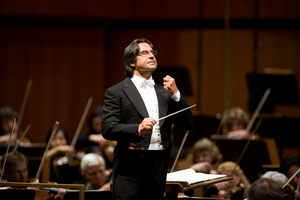Chicago Symphony Orchestra does everything right at Hill Auditorium (even 'The Victors')
What did you think of the concert? Leave a comment and/or vote in the poll at the end of this post:
Note: This story has been changed to correct Robert Chen's first name.

Riccardo Muti leading the Chicago Symphony Orchestra (publicity photo)
On the other hand, we did all applaud mightily at the announcement of another anniversary: 25 years at the helm for UMS President Kenneth Fischer; and we did all sing, as the orchestra, in a rousing valedictory, offered perhaps the grandest, sweeping-est version of “The Victors” ever heard in Hill.
In fact, it offered it twice. Since the audience participation was not perfect—a jovial Muti quieted the crowd after “The Victors” encore to say that he had marked one audience entrance ‘pianissimo’ in his score and, well, we belted it—the Maestro offered a do-over. Everyone got it right the second time, so now we can all say we’ve rehearsed and performed with the CSO under Riccardo Muti.
But the party began well before the orchestra raised its toast to the Champions of the West. In a program that began with Wagner, continued with a new work from CSO composer in residence Mason Bates and closed with Franck’s Symphony in d minor, the orchestra had the chance to show its strengths and its might, as well as its finesse.
The beginning of the concert paid tribute to Year One of Hill’s life as a concert venue: The overture to Wagner’s “Flying Dutchman” was among the works played when the hall opened in 1913. And it was the CSO that was on hand to do the honors then, too. Thursday’s centennial performance was thrilling. Some entrances felt a little storm-tossed, but the Wagnerian power of the roiling ocean and the sense of monumental forces at play were riveting.
The size of the orchestra was no less grand for Bates “Alternative Energy,” which the CSO premiered last February. Nor, in a way, was the scope of the piece—energy glimpsed at more-or-less 100 year intervals (from 1896-2222) across four movements.
Ann Arbor audiences got a taste of Bates’ interest in combining electronica with live orchestral sound when the San Francisco Symphony performed his “Mass Transmission” here last spring, during its American Mavericks concerts. Now as then, he was part of the orchestra to mastermind the electronic portions of the score, and now as then, he received a rousing ovation following the performance.
What’s interesting here, in “Alternative Energy,” is that the energy of the electronics aren’t alternative: the electronica offer additional, exciting sonorities that don’t feel grafted on as much as they feel layered in. In fact, in the second movement, “Chicago 2012,” the electronics—whooshes, clanks and pops he sampled at Fermilab—are the sort of jazzy, rhythmic beatbox “melody line” to which the orchestra provides underlying harmonies.
The storyline - from simple(r) times to apocalyptic and post-apocalpytic times—is not so much the point here as scene painting. The cranking of car motors evokes a junkyard (“Ford’s Farm: 1896-); eerie pedals open “Xinjiang Province, 2112-“ where fragments of pentatonic scales and “orientalist” musical details give way to a whomping techno nuclear meltdown. And in the last movement, I guess we’re in Iceland, only it’s warm and it sounds like Indonesia. Concertmaster Robert Chen was stellar throughout, in violin solos that are very much at the thematic heart of the entire work.
All that energy, and the orchestra and maestro’s obvious relish in dishing it up, didn’t appear to have spent them when they returned, post-intermission, for the giant Franck Symphony in d minor. The playing was superb—from every section; one was absorbed by both the orchestral sound (the balm of those violins in the first movement, for example) and by pacing that made the symphony’s motivic transformations utterly compelling. The Allegretto movement was especially lovely, filled with light and grace—and magnificent English horn playing from Scott Hostetler.


Comments
Stephen Landes
Fri, Sep 28, 2012 : 2:37 p.m.
If the story was corrected per the first comment (from WeiPing Teoh) then there should be notification at the beginning of the article as has been practice in other A2.com articles.
xmo
Fri, Sep 28, 2012 : 2:35 p.m.
Sounds like the writer had a great time!
WeiPing Teoh
Fri, Sep 28, 2012 : 2:14 p.m.
It's Robert Chen, not John Chen.
Bob Needham
Fri, Sep 28, 2012 : 4:25 p.m.
That's fixed now, thanks